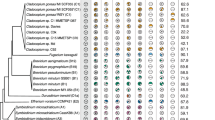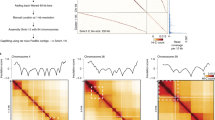Abstract
SEVERAL cytological and biochemical features of dinoflagellate chromosomes, such as low histone content1–3, threadlike appearance under the electron microscope1,4–6, absence of centromeres6, the condensed state persisting throughout interphase1,4–6, unusual DNA7 and the controversial possibility of multistrandedness8,9, suggest that the genetics of these organisms might be unusual. We report here initial experiments on the genetics of the heterotrophic marine, coccoid dinoflagellate Crypthecodinium cohnii10 previously believed to be asexual10. We have evidence of sexuality, complementation, recombination and a complex life cycle.
This is a preview of subscription content, access via your institution
Access options
Subscribe to this journal
Receive 51 print issues and online access
$199.00 per year
only $3.90 per issue
Buy this article
- Purchase on Springer Link
- Instant access to full article PDF
Prices may be subject to local taxes which are calculated during checkout
Similar content being viewed by others
References
Dodge, J. D., Arch. Protistenk., 106, 442–452 (1963); Arch. Microbiol., 48, 66–80 (1964); in The chromosomes of the algae (edit. by Godward, M. B. E.), 96 (Arnold, London, 1966); Bot. Rev., 37, 481–508 (1971).
Stewart, J. M., and Beck, J. S., J. Protozool., 14, 225–231 (1967).
Rizzo, P. J., and Nooden, L. D., Science, 176, 796–797 (1972); J. Protozool., 20, 666–672 (1973).
de Haller, G., Kellenberger, E., Rowiller, C., J. Microsc. Paris, 3, 627–643 (1964).
Grasse, P. P., Hollande, A., Cachon-Enjumet, M., C.r. hebd. Séanc. Acad. Sci., 260, 6975–6978 (1965).
Kubai, D. F., and Ris, H., J. Cell Biol., 40, 508–528 (1969).
Rae, P. M. M., Proc. natn. Acad. Sci. U.S.A., 70, 1141–1145 (1973).
Haapala, O. K., and Soyer, M. O., Nature new Biol., 244, 195–197 (1973).
Roberts, T. M., Tuttle, R. C., Allen, J. R. Loeblich III, A. R., and Klotz, L. C., Nature, 248, 446–447 (1974).
Javornicky, P., Preslia, 34, 98–113 (1962).
Gold, K., and Baren, C. F., J. Protozool., 13, 255–257 (1966).
Himes, M., Beam, C. A., and Berman, S., J. Cell Biol., 59, 143a (1973).
Franker, C. K., Smith, L. F., and Sakhrini, L. M., Arch. Microbiol., 90, 255–262 (1973).
Ornstein, L., Lab. Invest., 1, 250–262 (1952).
Patau, K., Chromosoma, 5, 341–362 (1952).
Lewin, R., J. gen. Microbiol., 6, 233–248 (1952).
Rubin, W. R., and Filner, P., J. Cell Biol., 56, 628–635 (1973).
von Stosch, H. A., Br. phycol. J., 8, 105–134 (1973).
Author information
Authors and Affiliations
Rights and permissions
About this article
Cite this article
BEAM, C., HIMES, M. Evidence for sexual fusion and recombination in the dinoflagellate Crypthecodinium (Gyrodinium) cohnii. Nature 250, 435–436 (1974). https://doi.org/10.1038/250435a0
Received:
Revised:
Issue Date:
DOI: https://doi.org/10.1038/250435a0
This article is cited by
-
Factors controlling induction of reproduction in algae—review: the text
Folia Microbiologica (2012)
-
Crypthecodinium cohnii with emphasis on DHA production: a review
Journal of Applied Phycology (2009)
-
Importance of life cycle events in the population dynamics of Gonyaulax tamarensis
Marine Biology (1983)
-
New observations on the twisted arrangement of Dinoflagellate chromosomes
Chromosoma (1978)
-
Algal sexuality
Nature (1976)
Comments
By submitting a comment you agree to abide by our Terms and Community Guidelines. If you find something abusive or that does not comply with our terms or guidelines please flag it as inappropriate.



